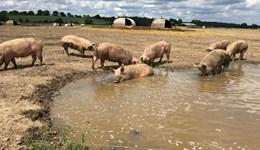|
Level of contamination |
Management |
|
Clean water |
Discharged to ditches and soakaways |
|
Lightly contaminated water |
Requires some form of particle trap (e.g. biological filters) and treatment such as swales/reed beds |
|
Contaminated water (anything with polluting potential) |
Contained and managed appropriately, e.g. slurry |
Drainage
Drainage systems transfer water from its source to its final destination. Good field drainage is important to ensure soils can be worked easily and yield well. It also enables producers to spread manures and slurries at the right time.
Systems must be designed carefully and good records should be kept. For an example of a site drainage plan, download our site drainage model template. The basic principles of field drainage, including maintenance and installation information, are covered in our practical field drainage guide. It describes how a small investment, such as locating and maintaining existing ditches and drains, can achieve improvements and rewards quite quickly.
You can find more information about adding value from pig manures and slurries here.
Rainfall and harvesting
Guttering, covered yards, slurry stores and segregated drainage systems can prevent the build-up of high volumes of slurry.
Rainwater harvesting is the collection and use of rainwater from buildings that would otherwise have gone down the drains, been lost through evaporation, or soaked into the ground. Plans must be carefully costed and depend on the amount of rainfall and complexity of any necessary infrastructure, such as controllers, filters and tanks.
Collected rainwater can be used for other jobs, such as rough-washing of tractors and machinery. Systems are available for allowing the first flush of rainwater to bypass any collection tanks, minimising the collection of dust and debris. Filters, purification or treatment may also be required. Since rainwater may present a biosecurity risk, advice should be sought from a veterinary surgeon before using rainwater in pig buildings or for livestock consumption.
You may find the ADAS rainwater harvesting in agriculture guide helpful.



